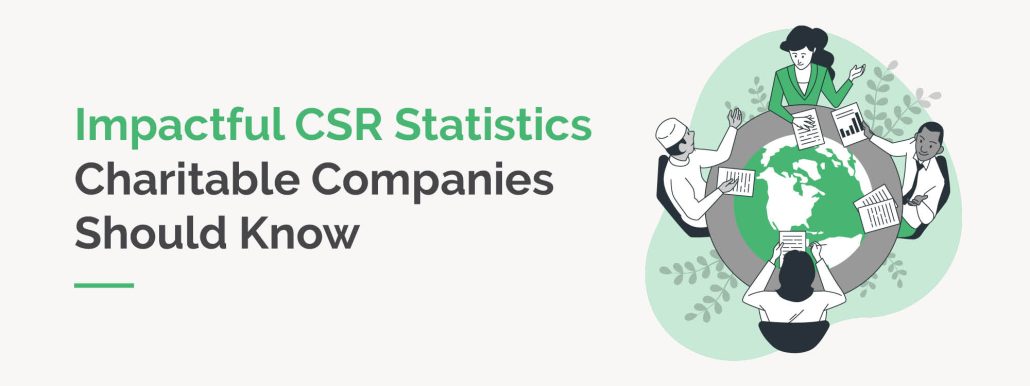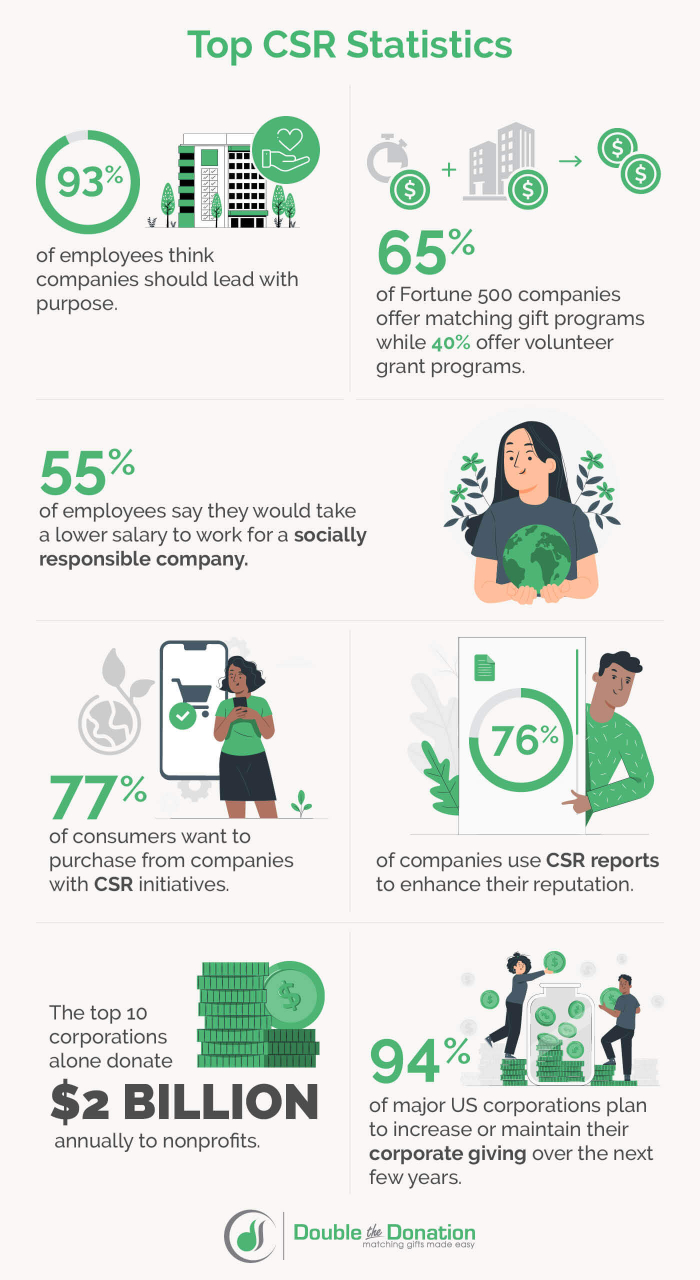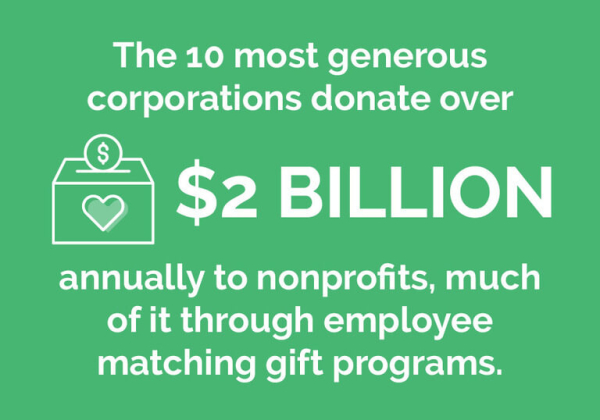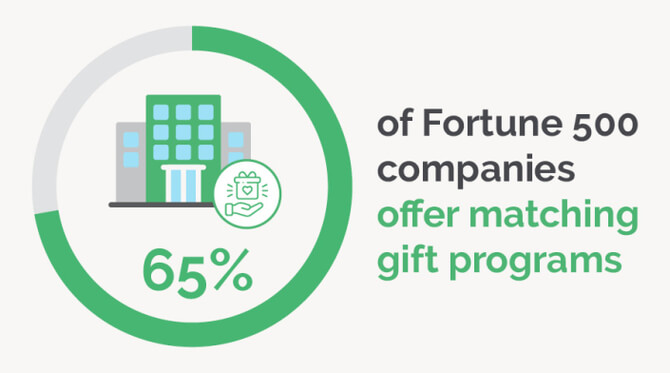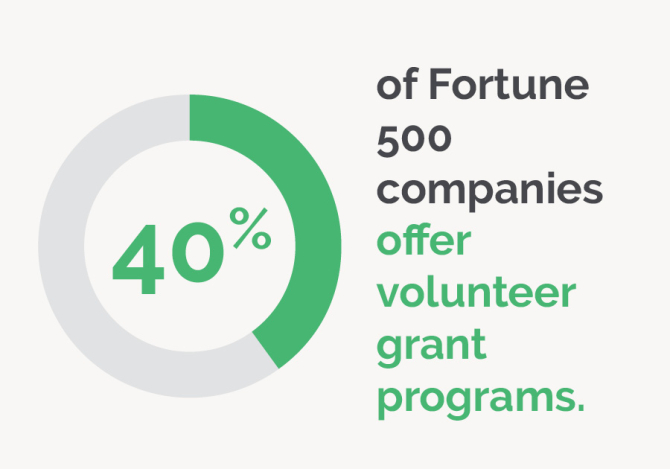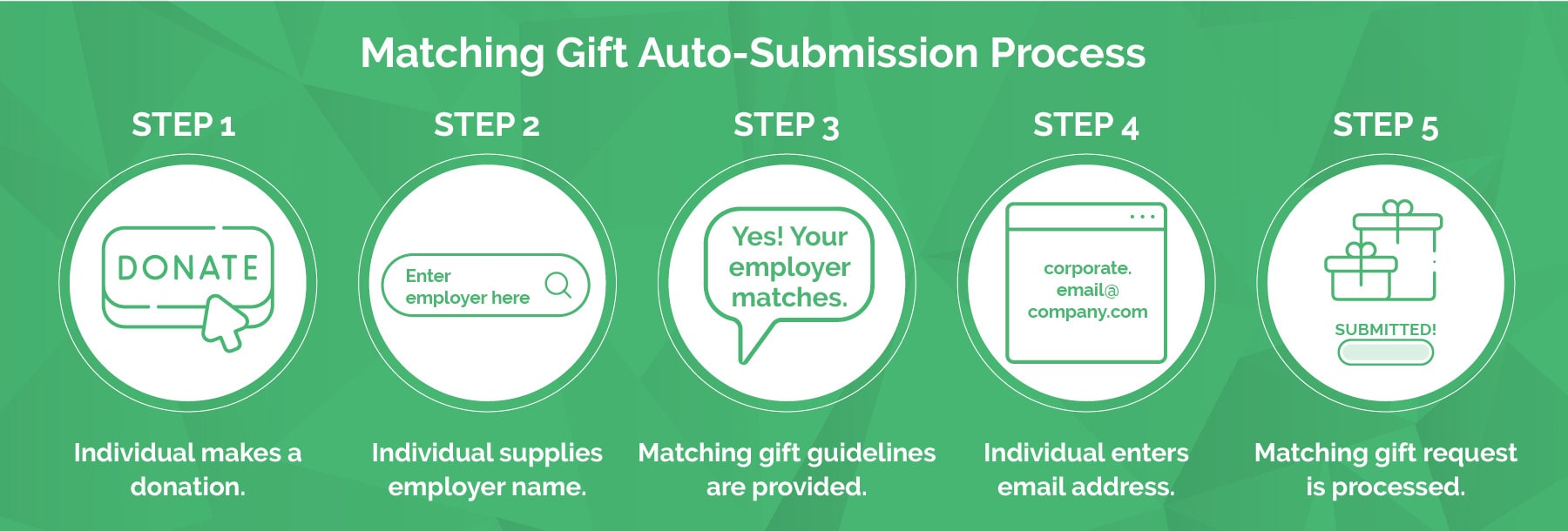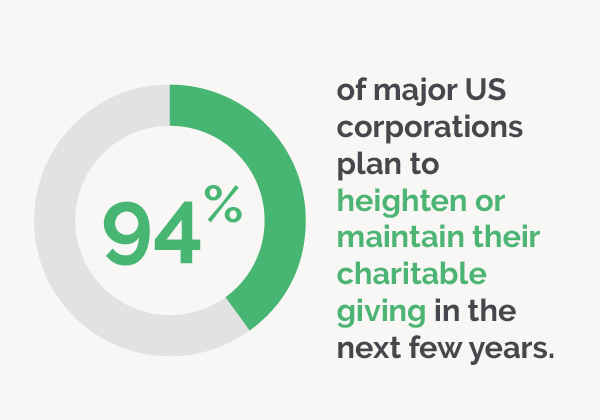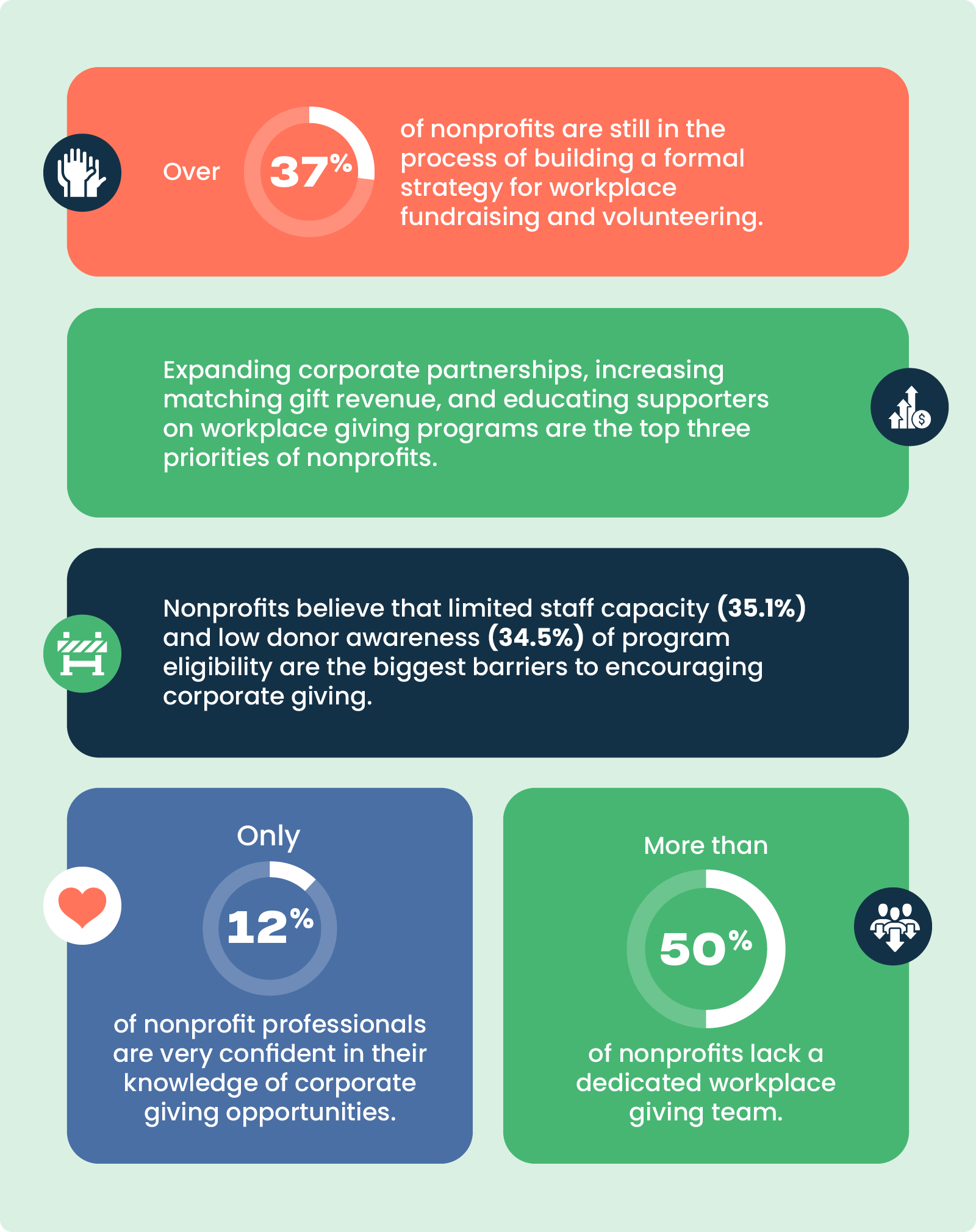16 CSR Statistics Nonprofits & Companies Should Know
The top companies know that sales alone are no longer everything. Instead, employees, consumers, and investors want to know that businesses are committed to making the world a better place in their everyday operations. And that’s where these CSR statistics come in.
CSR (or corporate social responsibility) encompasses a company’s efforts to contribute to society, from corporate philanthropy to environmental advocacy and beyond. Since CSR refers to various programs and initiatives, however, it can be difficult to conceptualize its impact and how organizations should approach it.
Thus, to illustrate the multifaceted nature of corporate social responsibility, we’ve compiled a list of 16 helpful CSR statistics here. This data will show the necessity of adopting CSR and which methods nonprofits should use to maximize it.
Let’s dive in!
1. 93% of employees think companies should lead with purpose.
When employees come to work each day, they want to feel like they’re making a difference. Even if their jobs don’t directly affect those in need, employees take comfort in knowing that the companies they work for use their revenue and team time for good.
As a result, companies should make sure employees are up to date with any relevant CSR initiatives. Employers might consider sending monthly or quarterly updates about steps the business is taking to make the world a better place, with teams taking pride in knowing their employers are committed to improving the local community.
For nonprofits, this ultimately means more employees working for philanthropic-focused businesses—and more opportunities for corporate giving!
2. 71% of employees think it’s important to work at a company that gives back through philanthropy and volunteering.
Employees want to get involved in their companies’ CSR efforts. Fortunately, the two easiest ways for them to do so are corporate giving and volunteering.
When a company starts a corporate giving program, it shows employees that the business cares about their interests—and wants to work together to give back to the causes they’re passionate about.
There are a variety of elements these corporate giving programs may include, such as:
- Matching gifts. Companies match employee donations to their nonprofit of choice, typically at a 1:1 ratio.
- Volunteer grants. Companies contribute to nonprofits based on the number of hours their employees volunteer.
- Fundraising matches. Companies apply funds to match revenue individual employees raise for walkathons, runs, or other events.
- Community grants. Nonprofits apply for grants offered by companies in areas such as disaster relief.
- Annual giving campaigns. Companies run specific fundraising campaigns during the end of the year or dedicated giving days.
- Automatic payroll deductions. Employees easily donate to their favorite causes on a regular basis, straight from their paychecks.
- Annual grant stipends. Companies distribute a predetermined amount of money to employees each year for them to donate to their nonprofits of choice.
- Internal employee fundraising. Nonprofits and companies rely on their team members to raise money for worthy causes.
- Scholarships. Businesses may help students pay for tuition, living expenses, food, and other associated costs.
- Sponsorships. For nonprofits hosting events, corporate sponsorships can be very helpful in securing necessary funding. Additionally, nonprofits promote and thank their corporate sponsors, allowing businesses to gain positive publicity.
In terms of volunteering, companies should encourage their employees to participate by developing a formal corporate volunteer program. This can involve reaching out to nonprofits to line up volunteer opportunities or surveying employees to find out which organizations they already volunteer with.
For nonprofits, that means more companies ultimately offering the programs and more opportunities for funding through volunteerism and other philanthropy efforts.
3. The top 10 corporations alone donate $2 billion annually to nonprofits.
The next of our CSR statistics quantifies the substantial impact social responsibility has on charitable organizations. Ultimately, your company’s CSR initiatives can provide much-needed revenue to nonprofits, which can use those funds to better assist their beneficiaries.
Companies interested in giving back are encouraged to locate nonprofit partners that align with the company’s core values and mission. For example, businesses that sell food products may partner with an organization that fights hunger. That way, the company’s CSR efforts will be more meaningful and authentic to its core values.
Meanwhile, nonprofits can make the most of this funding by looking into opportunities for matching gifts, volunteer grants, and more.
4. 65% of Fortune 500 companies offer matching gift programs while 40% offer volunteer grant programs.
The two most popular forms of corporate giving are matching gifts and volunteer grants. Matching gifts occur when an employee contributes to a nonprofit, and their employer matches that donation. While most companies match employee donations at a 1:1 ratio, others match at a 2:1 or 3:1 ratio.
As a result, matching gifts have the potential to double—or even triple—a nonprofit’s donation revenue. With this type of corporate giving, you incentivize supporters to give back to their favorite causes and help worthy nonprofits like yours earn more along the way.
Volunteer grants, meanwhile, are like matching gifts with a twist. Instead of matching donations, companies contribute to nonprofits based on the number of hours their employees volunteer. As a result, companies can have a massive positive impact on their nonprofit partners by offering them additional funds and corporate volunteers.
5. 65% of companies provide paid volunteer time off for employees.
This statistic highlights the growing popularity of Volunteer Time Off (or VTO) programs in the corporate world. All in all, VTO allows employees to take paid time off during working hours to volunteer for causes they care about, combining the professional and philanthropic spheres. The fact that nearly two-thirds of companies offer this benefit shows the increasing importance businesses place on corporate social responsibility (CSR) and employee engagement.
For nonprofits, this is an opportunity to partner with companies and tap into a ready and enthusiastic volunteer base. It also signals a shift in corporate culture, where giving back to the community is seen as an essential business practice rather than a secondary initiative.
6. VTO companies offer their employees an average of 20 hours per year.
On average, companies with VTO programs allocate between 8 and 40 hours annually for each employee to engage in volunteer activities—with the mean number landing at 20 hours each year. This represents a meaningful commitment, providing employees with sufficient time to make a significant impact without compromising their professional responsibilities.
For employees, these 20 hours can foster personal fulfillment and skill development. For companies, this level of support enhances employee satisfaction and retention, as individuals feel their workplace values their personal interests and community contributions. And that means more volunteer availability for organizations looking to secure no-cost support!
Meanwhile, nonprofits benefit by engaging highly motivated volunteers during this time, helping them achieve their missions more effectively.
7. 78% of donors are unaware if their company offers a matching gift program.
It’s difficult to make a large impact with a matching gift program if a company’s employees don’t know about it. That’s why it’s so important for businesses to include matching gift guidelines in their corporate giving policy and promote matching gift opportunities to their teams.
On the other hand, even knowing that a company’s matching gift policy exists doesn’t guarantee that supporters will participate. In fact, 16% of donors know their company offers matching gifts, but they’re not sure if they’re eligible or how to submit a request.
As a result, many nonprofits embed corporate giving database tools within their donation pages that allow donors to search for their employer, determine their eligibility, and submit a matching gift or volunteer grant request.
Typical nonprofit corporate giving software enables donors to fill out their information and send matching gift and volunteer grant requests to their employers. With auto-submission through Double the Donation, the process is even easier. All employees have to do is input their corporate email address, and the platform will send their employer the appropriate request on their behalf.
This approach ensures that more donors send matching gift and volunteer grant requests, increasing corporate giving participation and employee engagement.
8. 96% of companies find that employees who volunteer are more engaged than their coworkers who don’t.
Corporate volunteer programs give employees a hands-on opportunity to get involved in CSR. Thus, in addition to benefiting those in need, volunteering can also improve employee engagement for companies.
When a business organizes volunteer shifts for its employees, it gives them the opportunity to build valuable teamwork skills. Additionally, employees who work for companies that provide volunteer grants and other volunteer programs feel more empowered by their employer to make a difference.
After all, employees feel increasingly invested in companies when they can directly contribute to their social good efforts, leading to higher engagement in the workplace—not to mention more volunteerism for organizations!
9. 88% of Millennials find their jobs more fulfilling when their employers provide CSR opportunities.
With Millennials making up 39.4% of the workforce, it’s important to tailor your company culture to this large segment of working professionals. And an overwhelming majority of Millennials believe CSR opportunities enhance their roles.
For many corporate employees, their job descriptions don’t necessarily include helping communities in a direct way, but most people feel best about themselves when they’re making a positive impact on others. CSR opportunities help close this gap.
Employees who give to their favorite causes or volunteer with nonprofits through their companies’ corporate giving programs feel a greater connection to the business. In other words, CSR makes jobs more than just jobs. These types of initiatives empower people to work with their employers—and their favorite nonprofits—for the betterment of society. And nonprofits benefit from engaging in CSR opportunities, too!
10. 55% of employees would take a lower salary to work for a socially responsible company.
Many individuals feel so passionate about CSR that they would rather work for a socially responsible business with a lower salary than make a larger salary at a company that doesn’t prioritize CSR. And this data shows that companies in the midst of recruiting and hiring can entice applicants with their CSR initiatives.
While employees certainly want to (and should) be paid in accordance with their skills and experience, there’s a growing sentiment that job fulfillment is sometimes more important than salary. As evidenced by the two previous CSR statistics, CSR programs enhance the employee experience and make people feel connected to their workplace. It’s a win-win!
Therefore, companies that want to attract purpose-driven applicants should take the time to develop comprehensive CSR programs. That way, they can demonstrate their commitment to social good and encourage prospective employees to join in. As a result, corporate social responsibility will only continue to grow, with nonprofits at the forefront of these programs’ benefits.
11. 89% of corporate executives think employees are more satisfied when their company has a strong sense of purpose.
Not only do employees report that they prefer companies with a social conscience, but corporate executives also notice a difference in employee attitudes when companies are driven by CSR. Leadership teams recognize that corporate social responsibility gives employees something to work toward in addition to their career goals and aspirations.
When employees feel satisfied in their roles, they’re more likely to put their best foot forward in the workplace. As a result, employees will be more productive and invested in their work, resulting in better outcomes for business objectives while supporting their favorite nonprofits with their time and money, too.
12. 58% of companies say workplace giving programs are important in retaining employees.
One of the biggest challenges of running a business is retaining employees. Over the long run, it’s much more cost-effective to retain employees than hire new ones. Not to mention, keeping the same employees around allows you to leverage their expertise and knowledge of the company to drive your goals forward.
Since workplace giving programs make employees feel more fulfilled and engaged at work, they also help ensure employees stay with their current employers. As a result, employees who participate in corporate giving have 75% longer tenures in the workplace.
Meanwhile, workplace giving participation can help nonprofits retain their supporters, too! When donors and volunteers know their time and money will be stretched even further, they’ll be more inclined to participate time and time again.
13. 77% of consumers want to purchase from companies with CSR initiatives.
Employees aren’t the only ones invested in companies’ CSR programs, either. Social responsibility is becoming increasingly important to consumers, too—so much so that it’s influencing their purchasing decisions.
This statistic indicates the positive financial impact of adopting CSR practices on a company’s bottom line. To ensure customers know about the work a business does to better society, the company will want to advertise its CSR programs well.
Here are some examples of how they can do so:
- Posting pictures of corporate volunteers on social media
- Spotlighting how much a company donates to different causes each year on product packaging
- Updating customers on current CSR projects through newsletters or other communications
While CSR may (or may not) directly influence sales, it can reveal a company’s core values to consumers who feel inclined to support charitable businesses. And it unlocks opportunities for corporate partnerships, too!
14. 73% of investors look to invest in companies that improve the environment and society as a whole.
Investors have the potential to skyrocket a company to success. These days, investors are not only looking for companies with high profitability but also those that are making a positive impact on the world around them.
Implementing and reporting on CSR efforts can increase the likelihood that purpose-driven investors support a business. For companies looking for investors, try researching potential investors ahead of time—and include information about your CSR programs in your pitches. This is especially true for investors who have previously demonstrated interest in CSR!
Meanwhile, this provides nonprofits with unique opportunities to provide additional value for the businesses with which they partner.
15. 96% of G250 companies report on their sustainability efforts.
In its Survey of Sustainability Reporting, KPMG explains that the G250 list comprises the world’s 250 largest companies by revenue. Considering that nearly all of them report on their sustainability efforts, it’s suggested that other businesses do the same.
Reporting on a company’s CSR efforts, such as sustainability or philanthropy, increases transparency with stakeholders, including employees, consumers, and investors. And nonprofits can help by providing their corporate partners with detailed impact reporting data, too!
When a company compiles its annual report, it may notice gaps in its CSR strategy that can be addressed with the team. That way, the business can ensure its strategy is comprehensive and represents the company’s commitment to its values and CSR interests.
16. 94% of major US corporations plan to increase or maintain their corporate giving over the next few years.
CSR is not slowing down anytime soon. In fact, the majority of companies are growing their corporate giving programs to support even more causes and communities in the near future.
This data point indicates that CSR is not just a trend. It’s now a given for companies that want to stay relevant and positively perceived in the eyes of all stakeholders, and businesses should be following suit with their investments and resources. And nonprofits can continue to benefit from the programs as they grow and expand!
Insights from the Nonprofit Corporate Engagement Report 2026
1. Over 37% of nonprofits are still in the process of building a formal strategy for workplace fundraising and volunteering.
This indicates that many organizations recognize the value of corporate engagement but have yet to fully integrate it into their development framework. Without a structured approach, nonprofits may miss opportunities to align with corporate partners’ giving priorities or effectively mobilize employee participation.
2. Expanding corporate partnerships, increasing matching gift revenue, and educating supporters on workplace giving programs are the top three priorities of nonprofits.
This reflects a growing recognition that sustained growth depends on deepening engagement with both donors and their employers. By strengthening corporate relationships, nonprofits can unlock new funding streams and create mutually beneficial opportunities for employee participation.
3. Nonprofits believe that limited staff capacity (35.1%) and low donor awareness (34.5%) of program eligibility are the biggest barriers to encouraging corporate giving.
With often lean teams, many nonprofits struggle to dedicate the time and resources needed to effectively communicate workplace giving opportunities and eligibility back to their supporters. That means revenue-driving opportunities like matching gifts, volunteer grants, and payroll giving often slip through the cracks.
4. Only 12% of nonprofit professionals are very confident in their knowledge of corporate giving opportunities.
This signals a broader gap in internal education and access to resources that can limit fundraising potential. Without a clear understanding of available corporate giving programs, such as matching gifts, volunteer grants, and payroll giving, staff may struggle to identify or act on partnership opportunities.
5. More than 50% of nonprofits lack a dedicated workplace giving team.
This often means that responsibilities related to corporate partnerships and matching gifts are spread across multiple roles, adding pressure to teams that are already stretched thin. As a result, follow-up may be inconsistent, causing important opportunities to slip through the cracks.
Wrapping Up & Additional Resources
Whether you’re a nonprofit seeking corporate sponsorship or a company looking to amplify your social responsibility efforts, these CSR statistics should serve as a powerful reminder that impactful giving starts with intentional strategy.
After all, understanding and leveraging CSR statistics is vital for both nonprofits and companies aiming to make a meaningful impact. For nonprofits, these data points highlight the importance of aligning with corporate partners that value social responsibility. Meanwhile, for companies, they underscore the benefits of integrating CSR initiatives into their business strategies.
From boosting employee engagement to strengthening brand loyalty and increasing social impact, CSR is a win-win for all.
We hope these CSR statistics helped you better understand the trends and impact of social responsibility in nonprofit fundraising. For more information, check out the resources below:
- Corporate Giving and Matching Gift Statistics [Updated 2024]. Want to learn more about the ins and outs of corporate giving and matching gifts, two important components of CSR? Check out our list of relevant facts and figures here.
- Become an Expert: Access The Ultimate Guide to Matching Gifts. Get our complete guide to corporate matching gift programs! Learn the ins and outs of the matching gift experience, best practices for raising more, and tools to streamline the process.
- The Ultimate Fundraising Guide to Corporate Giving Programs. Corporate giving programs make up a significant portion of companies’ overall CSR. Explore all things corporate giving with this comprehensive resource.

